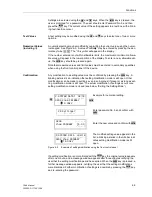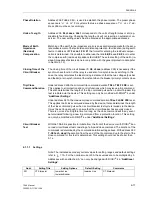
Configuration
5-60
7SA6 Manual
C53000-G1176-C156-2
has failed, this RTC is the first synchronization source for the internal clock, independ-
ent of operating mode selected.
In
Internal
mode, the system time is controlled using only the RTC as the synchro-
nization source. It may be set manually. The procedure for manual date/time setting
is given in Section 7.2.1.
If an external source is selected, only the selected synchronization source is used. If
the source fails, the internal clock continues unsynchronized.
If time synchronization is to take place via a master control system, the option
IEC–
60870–5–103
or
PROFIBUS FMS*
must be selected (Figure 5-57).
*: not available in firmware Version 4.0 and 4.1
When using radio clock signals, you must take into account that it can take up to three
minutes after device start-up or restored reception for the received time signal to be
decoded. The internal clock is not re-synchronized until then.
With IRIG B, the year must be set manually, because this standard does not include
a year value.
For synchronization using pulses via a binary input, the present device time will ad-
vance to 00 seconds of the next minute for values greater than 30 seconds when the
positive slope of the pulse arrives. For second values less than 30, the device time will
be set to 00 seconds of the current minute. Because this signal is not monitored, each
pulse has a direct effect on the internal clock.
For devices whose clock is synchronized by the “absolute time master”, you must
select one of the options with the supplement „...
or Timing Master
“ (No. 8 to 14
in Table 5-7). The device only uses the indicated source if it is not supplied with a time
from the “absolute time master”.
Synchronization
Offset
The “Synchronization Offset” (
Time correction
) setting allows correlation of the
time signal received from the radio clock to local time (time zone). The maximum set-
table offset is ± 23 h 59 min = ±1439 min.
Error Message
Based on Toler-
ance Time
The tolerance time (
Monitoring
/
Fault indication after
) for time synchroni-
zation fault indicates how long cyclical synchronization may be absent until an alarm
is given.
External or internal synchronization normally occurs every minute. The setting for the
tolerance time must, therefore, always be at least two minutes. Under poor radio clock
reception conditions, you may delay the trigger of the “error” status condition even
longer.
Changing the Syn-
chronization Mode
When changing synchronization mode, the hardware will change over to the new
source within one second. This causes breakdown of cyclical synchronization, and the
internal clock will be disrupted — as at start-up — until the new synchronization
source takes over.
After modification to the synchronization offset in the time signal/operating mode, or
when changing year in IRIG B, the cyclical synchronization is not lost, but there is a
jump. To call attention to this, the time value causing a jump is reported with “
Time
interruption ON
” — without the synchronization offset, and subsequently with
“
Time interruption OFF
” — with the synchronization offset.
Summary of Contents for siprotec 7SA6
Page 2: ...Siemens Aktiengesellschaft Book No C53000 G1176 C156 2 ...
Page 18: ...xviii 7SA6 Manual C53000 G1176 C156 2 ...
Page 32: ...Introduction 1 14 7SA6 Manual C53000 G1176 C156 2 ...
Page 82: ...Hardware and Connections 2 50 7SA6 Manual C53000 G1176 C156 2 ...
Page 119: ...SIPROTEC 4 Devices 4 25 7SA6 Manual C53000 G1176 C156 2 Figure 4 20 CFC Logic example ...
Page 190: ...Configuration 5 62 7SA6 Manual C53000 G1176 C156 2 ...
Page 652: ...Installation and Commissioning 8 78 7SA6 Manual C53000 G1176 C156 2 ...
Page 724: ...Technical Data 10 56 7SA6 Manual C53000 G1176 C156 ...
Page 800: ...Appendix A 76 7SA6 Manual C53000 G1176 C156 2 ...
Page 866: ...Appendix B 66 7SA6 Manual C53000 G1176 C156 2 ...
















































